How Scarborough seaweed highlighted by the Hairy Bikers is set to save the planet
Acres and acres of seaweed are being grown 30 metres under the surface. It used to be known for little more than being washed up on the beach and something to be avoided in a Chinese takeaway. But not any more. According to Wave Crookes, co-founder of SeaGrown, England’s first large-scale seaweed farm, the algae is the future when it comes to reducing our carbon emissions, the main cause of climate change.
A former Scarborough fisherman, sailor, deep sea diver and navigator for the British Antarctic Survey, Crookes set up SeaGrown five years ago with his partner, marine biologist Laura Robinson.
Advertisement
Hide AdAdvertisement
Hide AdThe couple met while he was navigating ships for the British Antarctic Survey and she was lead scientist. “We got talking and by the time she left we had decided that we really wanted to do something together and we wanted to do something that would do some good,” says Crookes, who grew up in Scarborough, the son of a local fisherman.
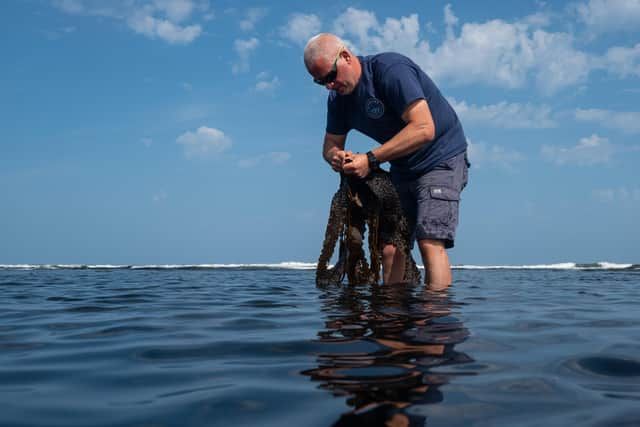

He left fishing to join the Royal Navy and then became a merchant seaman working on trawlers before becoming a deep sea diver and then went to work for the British Antarctic Survey. He is a man with saltwater running through his veins and also has dedicated a lot of his time to the RNLI, ensuring people stay safe on his beloved sea.
The idea he and Robinson came up with was to use seaweed’s natural health-giving properties for food, bath and cosmetic products. “We knew just how good seaweed is for you but people just aren’t going to eat a plate of raw kelp,” says Crookes.
And the right sort of seaweed doesn’t grow in abundance everywhere. You have to have the right kind of rocks and cliffs around the shoreline. The couple did look at Cornwall but, with Crookes’s knowledge and love of Scarborough, it was the natural place for them to start their business.
Advertisement
Hide AdAdvertisement
Hide AdAnd so they set about harvesting, washing and then drying the seaweed before turning it into seasonings that not only taste good but are good for you.
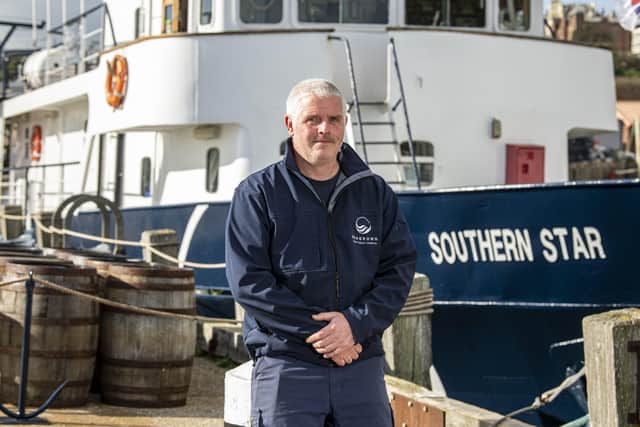

However, it soon became clear to Crookes and Robinson that seaweed had a far more important role to play in the future of the planet. “Scientists estimate that, acre for acre, seaweed is 20 times more efficient at absorbing carbon from the atmosphere than woodland is onshore,” he says. “At the same time as absorbing tonnes of carbon, seaweed releases oxygen into the surrounding water. It uses up other excess nutrients and creates new habitats allowing marine life such as fish, mammals and birds to flourish.” It is also used in the manufacturing of biodegradable products, biochemicals and nutraceuticals.
Another area is animal feed. The meat and dairy farming industry is a massive part of Yorkshire’s rural economy but it is also a significant contributor to greenhouse gas emissions. But many variants of seaweed, if added to a cow’s diet, can mitigate these emissions.
And so it also became clear that there wasn’t enough seaweed growing just off the shoreline of Scarborough to fulfil all their needs.
Advertisement
Hide AdAdvertisement
Hide AdBut you can’t just start growing acres of seaweed in the North Sea – you need to jump through lots of hoops and get a licence, says Crookes. “It is very closely monitored and we need to get a lot of permission and a licence. We are the first people doing this on this scale and so there is an awful lot of trial and error.”
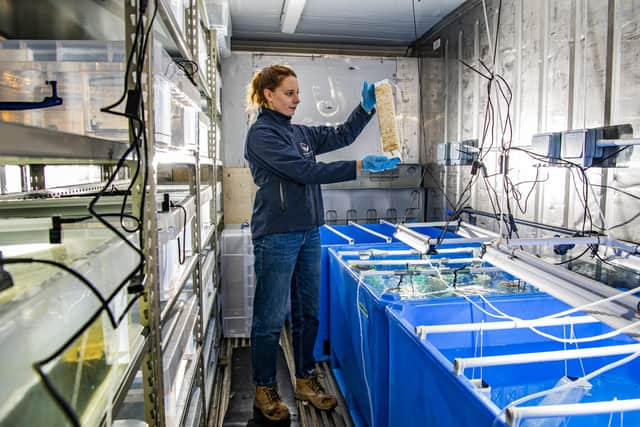

The North Sea off the coast of Scarborough can be a very unforgiving place, and Crookes and Robinson definitely learnt the hard way to start with as mother nature took its toll on their kit.
Crookes then applied some of his knowledge gained in the Antarctic and bought kit that could withstand everything the East Coast had to throw at it. “We now offer consultancy to those who are following in our footsteps,” he says.
As industry has seen the potential of seaweed, so has demand grown for SeaGrown’s products. So much so that in August it launched its first crowdfunding project in a bid to raise more than £27,000 to grow an extra four square kilometres. It reached its target in less than six weeks.
Advertisement
Hide AdAdvertisement
Hide AdSuccess also meant the couple needed somewhere to not only clean and process the seaweed they harvested, but also create their own laboratory and hatchery. They looked around the harbour in Scarborough but everywhere was either too expensive or not suitable. And then they came across Southern Star.
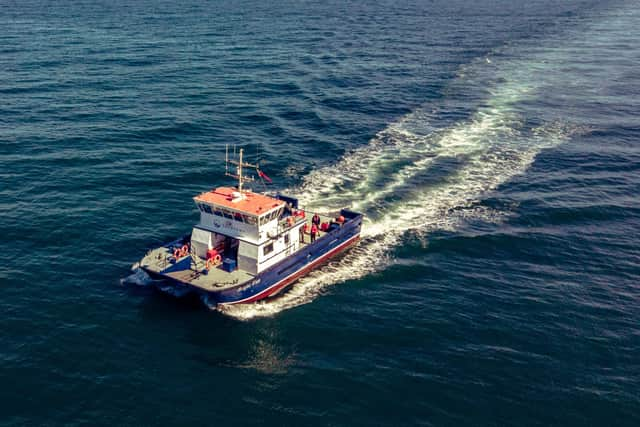

Southern Star had been lying on a berth at Clydebank in Glasgow for several years before she showed up on Crookes’ radar. She was in a sorry state and needed a full overhaul of all seven engines, which was completed by specialist engineers. She was first moved to a shipyard on the Isle of Bute and onto a dry dock where a team worked tirelessly to meticulously check every square centimetre of the hull, fixing every imperfection and section of corrosion before the hull was painted in the rich SeaGrown signature navy blue.
Cabins were removed on the upper deck to begin construction of a cafe and visitor centre onboard. At the same time, the cargo hold was cleared out and other internal areas modified to house a seaweed hatchery and onboard science laboratories. After returning to Clydebank for final checks, Southern Star was sailed to Scarborough where she is now the permanent HQ for SeaGrown complete with cafe, visitor centre and labs, with plans for an educational area as well.
It means the company can grow the seaweed seeds on ropes to a size big enough to be transported out to the farm. And another amazing fact about seaweed is that it grows so quickly. “Within three to four months, it is ready to harvest,” says Crookes.”It’s another benefit – it grows a lot faster than trees.”
Advertisement
Hide AdAdvertisement
Hide AdIt is clear Crookes is proud of the achievement. He is also proud of their “workhorse” boat, Bright Blue, which is used to not only ferry the crew to the seaweed farm but enables them to harvest it and bring it back to harbour.
A recent appearance on TV cookery show The Hairy Bikers Go North saw an escalation in demand for SeaGrown’s products and as a result they sold out. “It wasn’t the seaweed particularly that we ran out of, it was the packaging,” says Crookes.
SeaGrown now has a team of nine which is likely to increase if plans for scallop and oyster farming go ahead.
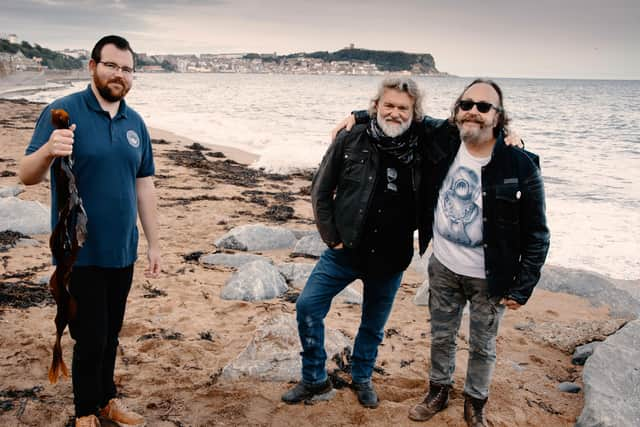

The pandemic, Brexit and other global factors nave meant that Crookes’ and Robinson’s plans for the development of the seafood side of the business are on hold.
Advertisement
Hide AdAdvertisement
Hide Ad“We just want to see what happens,” says Crookes. “We have more than enough on our plates with the seaweed side of the business at the moment. The pilot project for the seafood is progressing but plans to expand it are definitely on hold for the moment.”
And as more targets are set for reducing our carbon emissions, demand for SeaGrown’s seaweed looks set to only increase.
www.seagrown.co.uk
Comment Guidelines
National World encourages reader discussion on our stories. User feedback, insights and back-and-forth exchanges add a rich layer of context to reporting. Please review our Community Guidelines before commenting.